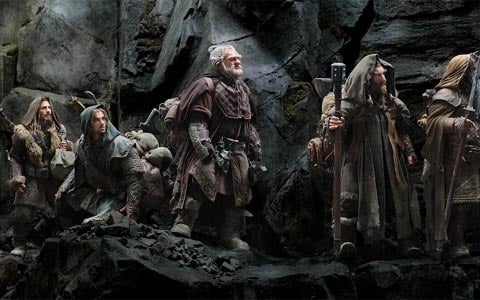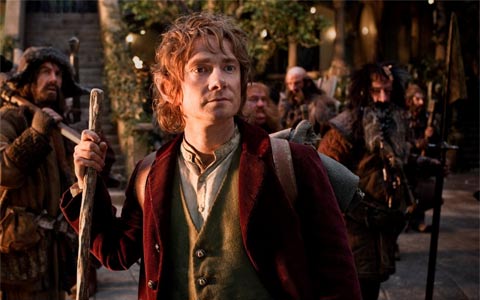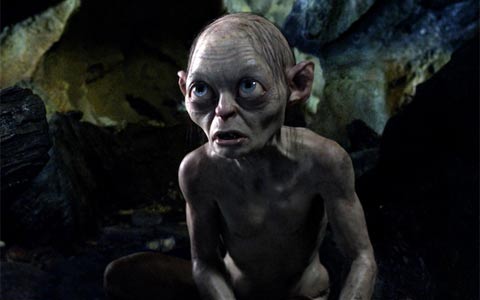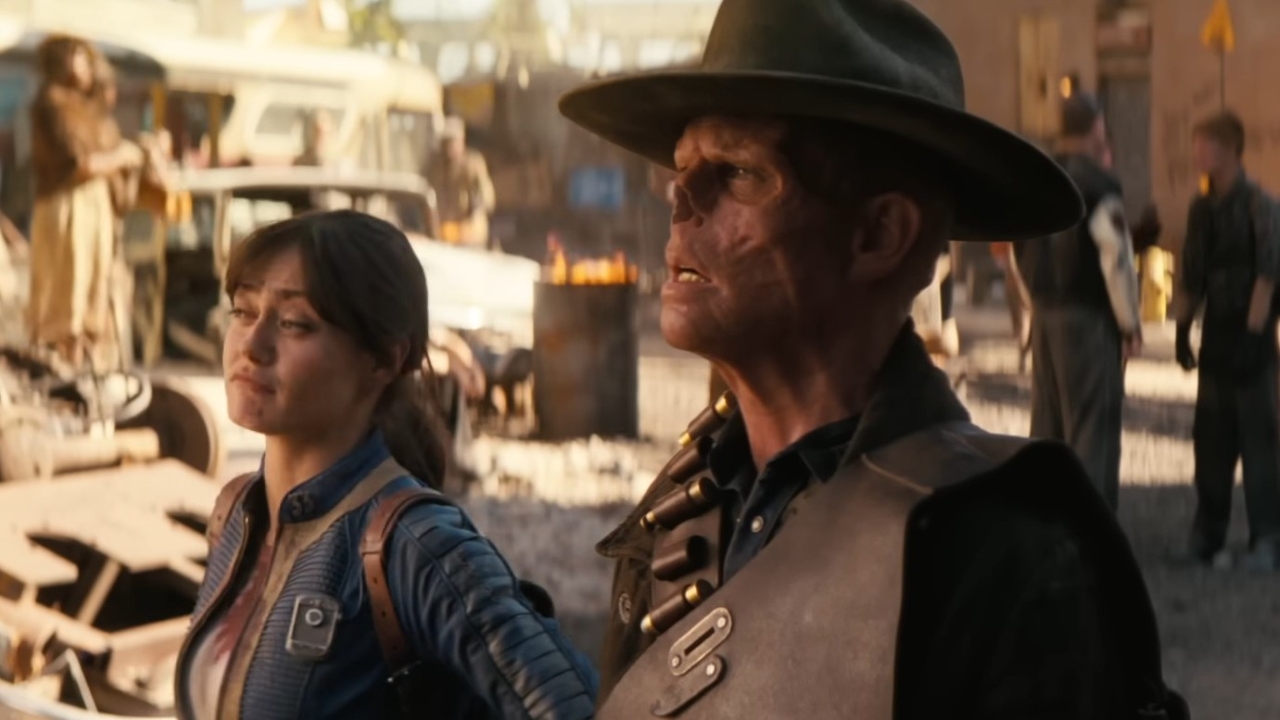On The Set Of The Hobbit, Joining Peter Jackson On An Unexpected Journey

Set visit embargoes are a funny thing. While we here at Cinema Blend often get the chance to fly around the world and watch movies as they’re being made, in most cases the trips come with enforced non-disclosure agreements that force us to remain absolutely silent about what we’ve seen or where we’ve been until an undisclosed date. As these special vows of silence can last for months on end, it can be a very hard, difficult time, particularly when the movie set you’ve visited is one of the most hotly anticipated movies of the year. For that reason, I’m tremendously excited to announce that back in May I flew from my Los Angeles home across the International Date Line to Wellington, New Zealand where a group of journalists including myself were invited to the set of The Hobbit: An Unexpected Journey.
Over the course of an amazing five day trip, we got to spend nearly two full days on set where we had the chance not only to speak with the brilliantly talented people who appear in front of the camera – such as Sir Ian McKellan, Martin Freeman, and the host of performers who play the company of dwarves at the center of the plot – but also to the stunningly talented artisans and filmmakers responsible for bringing Middle Earth to life. Over the next few days I’ll be posting a number of articles about the experience, giving you the full inside access to the creation of The Hobbit, and it begins with our fascinating discussion with director Peter Jackson and our tour of the various departments that work to make the movies as breathtaking as possible.
The King Of Middle Earth
When thinking about the success of the Lord of the Rings trilogy, it’s amazing to think that The Hobbit almost didn’t happen. But it’s also scary how close that almost came to being reality. While the project was still in its development stages it experienced set back after set back, comparisons being made to director Terry Gilliam’s attempts to try and make his vision of Don Quixote. MGM was going through bankruptcy; Guillermo del Toro, who was originally attached to direct, decided to move on to other projects; a fire ravaged and destroyed everything in one of the New Zealand-based workshops; and actors union issues almost forced the production to move to Eastern Europe. But even with all those issues and a terrible fear about making a movie featuring 13 dwarves as lead characters, director Peter Jackson told us on set that where he ended up was exactly where he wanted to be.
“I never wanted to do The Hobbit, in the first place,” Jackson told us while we were on set and he was in between takes, sporting a nifty pair of Iron Man style 3D glasses around his neck. “'The idea of having an ensemble of 13 dwarves terrified me and I thought, ‘Well, it's going to be much more interesting to have another filmmaker dealing with that I'll just go with it and see what happens.’ …But the weird thing with this is that having ended up where I am, the fact that there's 13 dwarves in it is the great joy of the movie. I've actually swung a 180 degrees round now. It's like I suddenly think, "Wow, this movie is really cool because of all these characters, these eccentric dwarves." And we've given each of them personalities and things and they are very much the heart of the story. Bilbo is the soul of the story, but the dwarves and their wanting to reclaim their homeland is very much the heart of the story. I like these guys now. Actually I'm pleased it ended up the way it did.”
Helping in that respect is the fact that it seems the film got all of its problems out of the way during pre-production. Describing the movie as “a lot of fun,” and “just a joy,” the director even went as far as to say that one of the early calamities ended up helping the movie as whole. “I got an ulcer, which was awesome,” Jackson said sarcastically. “But [it] was actually quite good because it gave everybody six weeks of extra pre-production time…literally the art department, wardrobe costume, they all got an extra six weeks to prepare for the movie, so I think there was a lot of people that were quite happy about that.”
As for his key to approaching the material, we learned that it falls somewhere right in the middle of making the production feel exactly like The Lord of the Rings while also making sure it’s something different. The process begins with being true to the world that’s being created and pretending that Middle Earth is a real place, but from there it’s about finding the proper tone, and for that Jackson went straight to the source: J.R.R. Tolkien’s books. Contrasting The Hobbit with Lord of the Rings, Jackson said that the earlier trilogy is more about the battle between good and evil, while this one is more closely related to a fairy tale. “The elements of the story give you room to change the tone slightly, but in terms of the look and the feel and the filmmaking style I wanted to keep it pretty consistent and keep everything feeling like it's the same world,” Jackson said.
Your Daily Blend of Entertainment News
But tone isn’t the only thing being changed for the new trilogy – there’s some major visual changes as well. Early in the production the director made the controversial announcement that not only would The Hobbit movies be shot in 3D, but they would be filmed at 48 frames per second, a rate twice as fast as the standard 24 frames per second. A good amount of outcry resulted, with some fans upset that the new movies wouldn’t have aesthetic fidelity to the earlier movies, and others complaining that faster frame rates make everything too realistic – an element not desired in what is very much a fantasy world. In spite of protest, Jackson continues to defend his choice, explaining the importance of embracing new technologies and not just sticking with the status quo just because it’s what we’re used to. Said Jackson,
“I just think that we're living in a world where the technology is advancing so rapidly. You're having cameras that are capable of more and more-- The resolution on cameras is jumping up. Three or four years ago filmmakers using digital cameras were shooting at 2K and now we're shooting this at 4K and I'm sure within three or four years it'll be 8K. It's just going insane with the development, the speed of it, and likewise projection. And shortly the one thing we're all hanging out for is brighter projection for 3D, but the laser projectors are on the horizon and they're certainly going to massively improve the brightness, and theatres are building bigger screens.And it's really a question of do you just say, ‘Okay, this is what we've been used to for the last 75 or 80 years, and that's what we're going to stick with.’ Or do you explore ways to actually harness this technology to give people a better experience, and we're also, as an industry, we're facing a situation where less young people, especially, are coming to see films anymore. It's too easy to watch them on your iPad. Too easy to stay at home and play games, and so I think anything that we can do to provide a more immersive and spectacular experience-- Filmmakers have been doing it, 65mm, 2001… Kubrick and David Lean, they shot in these huge big formats to try to make it sharp and clear and that was like the equivalent of 5K in the film stock days. Todd-AO was 30 frames a second, wasn't it, for Around the World in 80 Days. There's been people trying to push it, but of course the just effect for seven or eight decades projectors were pretty much locked into 24 frames per second. We had to get past the mechanical film age to be able to explore other things, but it will be interesting. I personally think 48 frames is great, but we'll just wait till everyone can just see a whole full length movie, graded and timed and we'll see what people think.”
(Stay tuned for the rest of our interview with Peter Jackson, which will be posted later today!)

Bringing The Characters To Life
Given the incredible number of dwarves, goblins, hobbits and other assorted monsters in the movie, the hair, makeup and prosthetics department of The Hobbit production is constantly working to get actors prepared for being in front of the camera, whether they are having their entire look changed or just getting a wig and a big nose. During our second day touring the production, we were brought into the hair, make-up and prosthetic design department – with featured walls lined with hundreds of wigs and various life-like silicon feet, arms and more – where we discovered the painstaking task that comes with creating hobbits, dwarves and a variety of other beings during the shoot.
“The longest make-up of the dwarves is the Bombur make-up, which is the highly more intense one,” said Tami Lane, the film’s Oscar winning prosthetics advisor. “He's the only one with a full face, like cheeks under the eyes, forehead, chin piece, chin hair, bald-- He's about an hour and three-quarters. And our shortest make-up is Kili, who for us, for prosthetics, is thirty minutes or less. Today, he was done in twenty. But that's 'cause he has just a nose. He's one of our ones that doesn't have the full forehead, he just has a nose.”
The department is a major part of the production, and has as many as 55 and 60 people working at one time. We were told that there was a scene coming up the next day with over 200 actors involved needing work done. And that doesn’t even include the work done on the principal cast. Peter King, the picture’s makeup and hair designer, said that they had six wigs and eight beards for each member of the Dwarf company, mostly because of the different ways the characters were being shot.
“We've had to cover them in so many different aspects, King said. “The artists themselves have had to have two, then there's been a scale double, a mask double, a riding double, a stunt double-- That's six, yeah. And then we've had a couple of extra beards, 'cause we've actually taken wigs and put them on masks and taken them off and put them on people, what with the two units going as well.”
A major boon to the production, however, is that not only were members of the staff around back when they were making The Lord of the Rings trilogy (Lane and King included), they were actually able to take pieces made during the production of those films and reapply them for The Hobbit. An example of this is the elf ears, which they learned is best made from gelatin instead of silicone. “They're easy to go on, but the downfalls on this is they suffer under heat and moisture,” Lane told us. “But since they're just on the ear tip, you don't actually sweat on your ears, so they maintain pretty well. The one make-up technology that's been kept the same thirteen years ago is still the same now, is the Elf ears.”
While they weren’t able to reuse prosthetics from the first trilogy, wigs are a different story. King said that at the start of production they were able to go back and take the hair pieces for Cate Blanchett’s Galdriel, Orlando Bloom’s Legolas and Elijah Wood’s Frodo and recycle them for The Hobbit. In addition to being a real time saver, the decision also saved the movie a good amount a money. Why? Because wigs are surprisingly super expensive.
“$10,000,” King revealed when asked about the cost of an individual wig. “To have make this wig, is around five thousand pounds, so that's about ten thousand dollars… It's not cheap. I get the wigs made in England. Best wig maker in the world. And Peter, we've used-- On all Peter Jackson's films now, he's made all the wigs for everything we've ever done. They are the best. They are probably the most expensive as well, but you do see it when you see it on the screen.”

Dressing The Part
Watching the Lord of the Rings movies you may have noticed that the inhabitants of Middle Earth don’t spend a great deal of time wearing t-shirts and jeans. Instead, there’s a very medieval fashion sense in the fantasy world, filled with protective leather, cloaks and hoods. But one area where The Hobbit differentiates itself from its predecessor is in terms of color.
Delivering a presentation in a room filled with Bilbo, dwarf and Gandalf costumes, Bob Buck, who is credited as an Additional Costume Designer on the movie, told us that the change in tone between The Lord of the Rings and The Hobbit has had a significant effect on the way the costumes are made. “The Hobbit itself reads lighter in a bit more like a fairytale, I suppose,” Buck said. “So in lots of ways, we've amped up the color in our world now. We're relating it to what it was, but we've amped things up a lot.”
Beyond the tone of the new movie being much more jovial, Buck also has a practical theory as to why the look has changed so significantly. “The Ring hadn't actually been in Hobbiton now. In The Lord of The Rings, the Ring had been there, and had been tucked away in an envelope, tucked away in a special chest or whatever. But the evil and the menace, and the bad magic that that emanated, I think sucked the life and the color out of Hobbiton. And that gives us a bit more of a raison d'être.”
But more than just being about tone, there’s also the fact that the events in the new films occur six decades before Jackson’s first trilogy. In the same way that our clothes today don’t look like they did in 1952, the fashion sense in Tolkien’s world has changed too. “We looked at 18th century and we looked at pastoral things. We looked at a lot of folk costume. We looked at Sardinian folk costume. We actually really went right out there to look as far as we could, to be as eclectic as we could, 'cause we didn't want it to be a period.”
One of the most important tasks taken on by the costuming department was the development of Martin Freeman’s style as Bilbo Baggins. While we got to see an older version of the character – played by Ian Holm – in the first three movies, Bilbo’s look as a very defined influence this time around. Said Buck about Bilbo, “He's an English country gentleman. There was often talk from Peter of wanting Tolkien himself to be an influence. So just looking at Tolkien, how he had a jacket on, how it's always there, he was smoking a pipe-- There's these qualities of a country gentleman, who Peter wanted us to emulate.” Overall the costume Bilbo wears undergoes six stages of wear and tear throughout the series.
The dwarves are a different story. Described by the professional as “a rough and ready bunch” in “a biker gang in a way,” the characters’ designs weren’t based on real people, but instead were made to have the costume reflect specific personality traits and highlight each of the 13 members of the company as individuals.
“Thorin's of a kingly line,” Buck told us, “with his nephews Fili and Kili. You've got Balin, who's a Lord, basically a counselor, the literary sort of world. You've got Dwalin who's a head of the military-- a General sort of fellow. Also Gloin, who's high up there in the military ranks. His brother Oin, who serves as a sort of medical practitioner in this one. He's got the healing qualities. So these are of an upper class, I would say. Definitely Thorin. And these are around his world. So these would have been in that echelon of his place of standing. And then we go to what would be more the middle class, which is the brothers here: Nori, Dori, Ori. Probably a merchant class. He came to look after him, 'cause he dragged him along. It's a great relationship between these three. They banter and wind each other up and get involved. He's a bit of a merchant showman, he's the one who's always dressed up.”
As you can imagine, all of the prosthetics, wigs, makeup, layered clothing, and heavy props make getting into character a hot, gross ordeal – not to mention a potentially dangerous one. To combat the risks of overheating, the costumes are built with cooling vests underneath all of the layers. Between shots the actors are brought what Buck calls “their little Dwarf Handbags,” which are used to pump cold water through the cooling vest and give the performers some relief.
There are also characters like Gandalf, played by Ian McKellen, who have appeared in all of the movies thus far. For his part the costume has largely stayed the same, with an exact replica of the hat being produced along with the cloak, but even the great wizard is getting a new bit of flair for The Hobbit. “We've just added in one additional piece here,” Buck said, pointing to a mannequin with Gandalf’s costume, “which is an Elven scarf, which was a gift to him from the Elves. It was actually in Movie One, it was just sitting on his cart when he first trundled into Hobbiton.”

Weta Magic
The Lord of the Rings trilogy wasn’t just a worldwide phenomenon that launched director Peter Jackson into superstardom, but it also revealed New Zealand’s own Weta Digital and Weta Workshop to be one of the best visual and special effects companies in the entire world. After winning several Academy Awards for their work on Jackson’s earlier films, it was a no brainer that they would be back for The Hobbit as well.
Of course, with new projects comes new challenges, and The Hobbit presents a big one for digital effects. Because the director made the decision to film at 48 frames per second – double the standard 24 frames per second – the folks at Weta Digital literally had to do twice as much work…and that’s not even mentioning the decision to make the movie in 3D instead of 2D.
“Strictly speaking we don't do twice as much animation, although, because the animation is being seen with more acuity we have to take things to a level that we wouldn't have to at twenty-four, but just in terms of the processing and the calculation, we're generating twice as many frames,” said Matt Aitken, a visual effects supervisor and 18 year veteran at Weta Digital. “Actually, the switch from 24 to 48 technically has much less impact on us than the switch from 2D to 3D Stereo did. Lots of techniques and shortcuts and tricks of the trade that we had been using up until that point in the 2D world quite successfully were instantly revealed for being filmed elements on cards. In 3D Stereo they just became immediately apparent that that was the trick that we were working. So we had to completely rethink the way that we did lots of the basic tools of the trade if you like.”
New issues exist on the practical side as well, but obviously they come packaged differently. Unlike The Lord of the Rings where there were a number of human-sized characters to work with, with The Hobbit Weta Workshop is having to deal with a number of much smaller characters with peculiar and challenging proportions. Richard Taylor, a supervisor with the company, spoke with us about the process of designing a proper looking dwarf, sitting us all along a long table packed with various swords, maces and other Middle Earth weaponry.
“A dwarf, as we know a dwarf from our own world, is averaging about a five-to-one head-to-body ratio,” he said. “So what we're trying to do with all endeavors, is give the impression that they have a larger head to a more truncated and stout body. And the easy way to achieve a great deal of that is through body padding, and giving them large suits that they wear under their clothing. But of course, it's one thing to increase their body, lower their waist-line, drop their knee-lines down, make them look thicker in their limbs and heavier. But, of course, it's a whole other challenge to start tackling their prosthesis, their hair, their hands, because, of course, if you increase their head in size, you in turn have to increase all the other naked parts of the body, such as their hands and their feet.”
The new film also gave the divisions a chance to improve on what they had already created for The Lord of the Rings. For example, they were able to make great strides in the development of the legendary big and hairy hobbit feet. While they were working around the actors bare feet while making the first three movies, this time around they were able to make use of a product on the open market: ninja shoes. “[They] that suddenly came on the market a couple of years ago, with a very beautifully formed instep-supporting foot and open top and I think they were developed for running. We utilize those inside our silicone prosthetics.”
The real key to the company’s progress is to keep looking forward and finding new ways to build and approach new material. “We can never rest on our laurels,” Aitken said. “And I think you can see that in the history of the work that we show. And it's going to be really great with Gollum, because with Gollum we got an opportunity to look at the development that we've done over the last ten years. Here's the same character, but under the hood we're approaching him in quite different ways.”
Stay tuned here on Cinema Blend for even more about my trip to the set of The Hobbit and, as always, you can see more from the film in our Blend Film Database.

Eric Eisenberg is the Assistant Managing Editor at CinemaBlend. After graduating Boston University and earning a bachelor’s degree in journalism, he took a part-time job as a staff writer for CinemaBlend, and after six months was offered the opportunity to move to Los Angeles and take on a newly created West Coast Editor position. Over a decade later, he's continuing to advance his interests and expertise. In addition to conducting filmmaker interviews and contributing to the news and feature content of the site, Eric also oversees the Movie Reviews section, writes the the weekend box office report (published Sundays), and is the site's resident Stephen King expert. He has two King-related columns.
